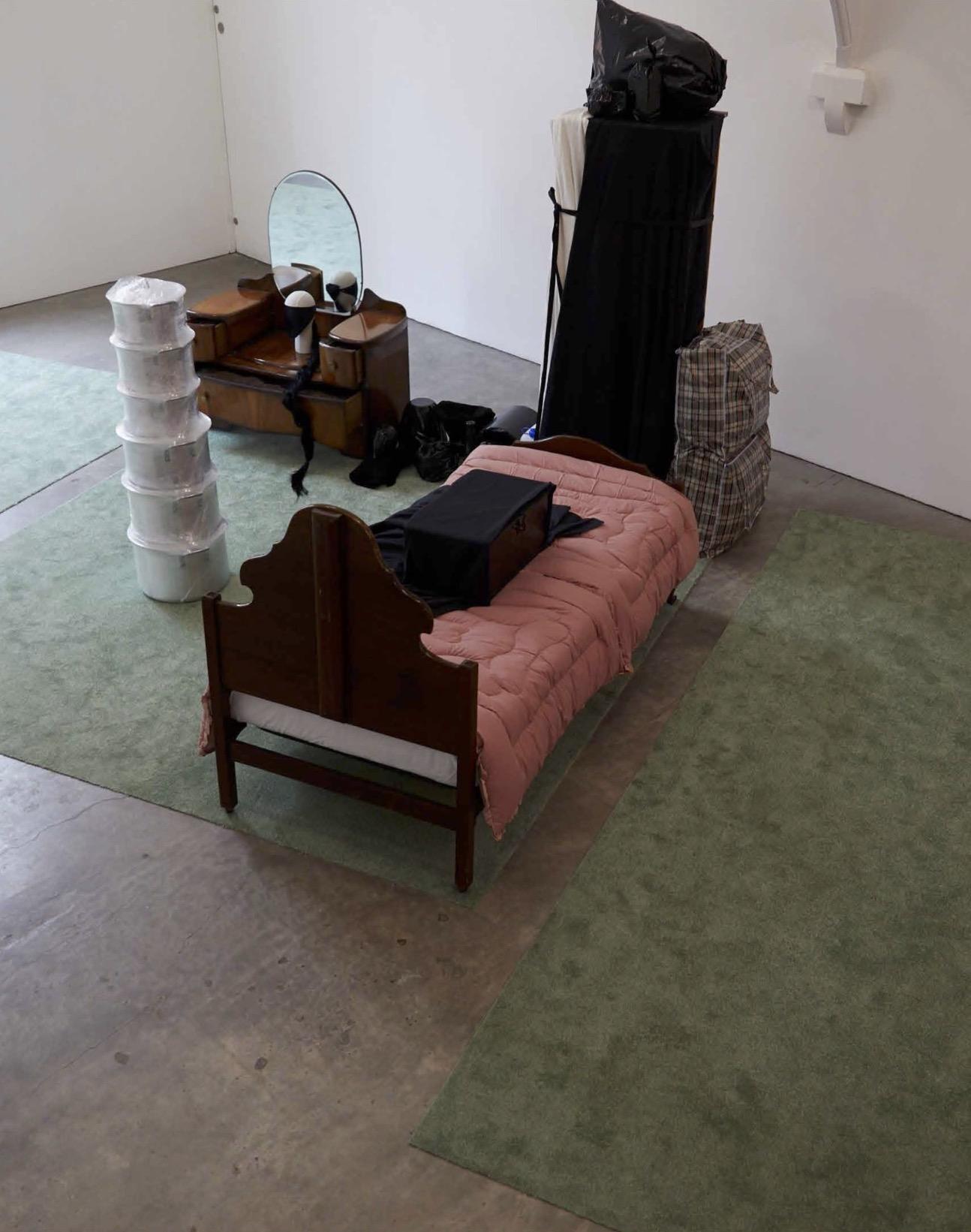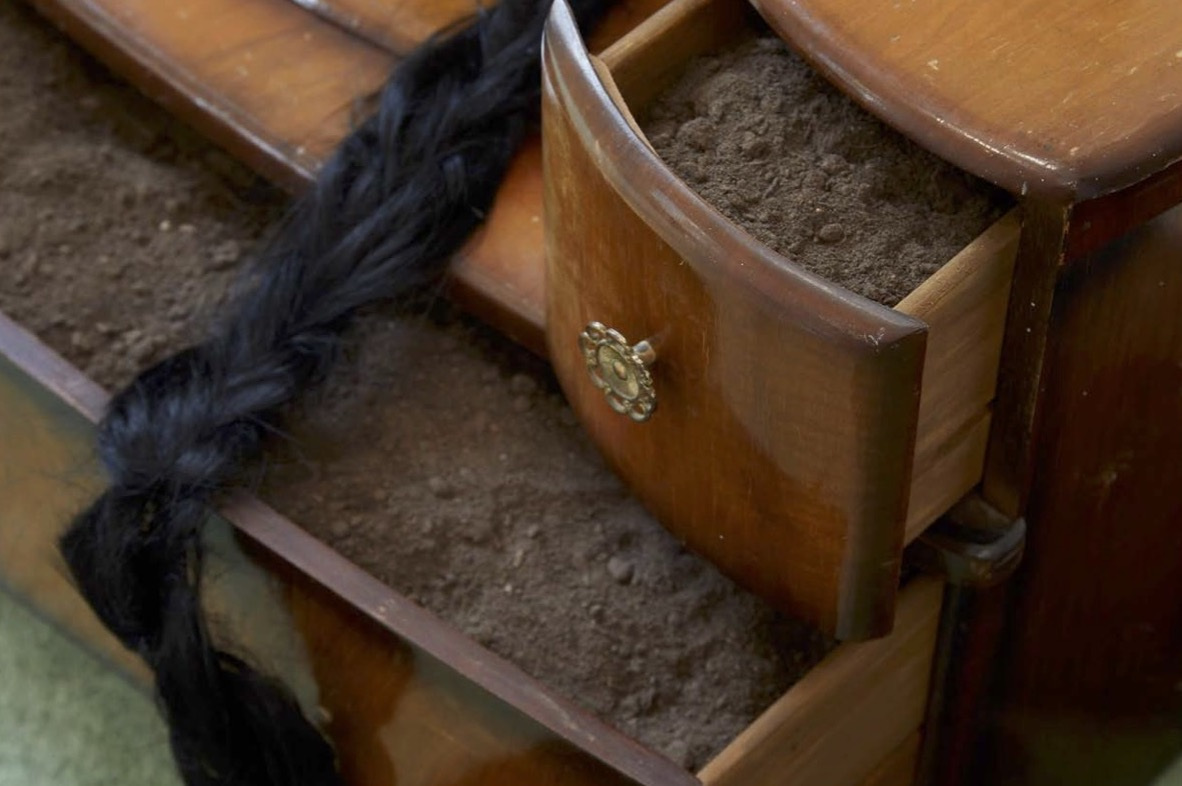An Immigrant’s Room of Her Own
2018Installation, a series of symbols,
Solo Show, ‘Being Somewhere Else’
Ikon Gallery, UK
In this room of her own, objects are perpetually wrapped, packed, deferred for later.
The hoping, plotting, preserving for the future is an explicit feature of the space. There
are mysteries tied up, covered in plastic, reverently saved. Will she never quite unpack?
The mood of the voyage endures. She is always arriving.
For the immigrant woman, home is a receding idea of home, home is a possible future. She is actively creating a home that will never quite come into being, that will remain a half-dream. Is there a side of the immigrant woman herself that will remain wrapped, enclosed, preserved for later?
In 1928, in her dazzling meditation, A Room of One’s Own, Virginia Woolf did not address the situation of the migrant woman. The novelist’s capacious imagination did not reach as far as the migrant woman’s life, to the violence in her home, to the daunting puzzle of a new culture. But if it had she would have written this room, invoked its achievement, its aspiration. She would have seen the importance of this limited safety, this small private place to imagine, store, work. Here the immigrant woman makes dresses, touches fabric; this is her place in a home that is very definitively not safe, that offers no privacy, that places women at the bottom of every hierarchy; this is her sanctuary.
Is this space, she will work to feed the children who will go on to be artists, university lecturers, government employees, entrepreneurs. For the immigrant woman, her children’s lives are also her art, her supreme and wily act of invention; they will live in ways she cannot even imagine, move sleekly through spaces she can’t decipher, but that possibility, that shimmering unknown, is her creative act. To save, hoard, wrap, to send off to school each day, to protect, to fail to protect, to be baffled, to be alienated, to love.
The obstacles for the immigrant woman are more extreme even than those Woolf addresses in her history of the empire, and yet the beauty of the idea applies and endures through the uprooting. The room of one’s own.
To make a home in a new world, to prepare, pack, for a future you can’t know in a place you don’t understand. This impossible home-making is the immigrant woman’s task. But Woolf saw that the space to think it through, to retreat, to refresh, this modest bit of physical space of her own is essential. She saw that our material conditions define our creations, our output on earth.
Woolf writes, “When I ask you to earn money and have a room of your own I am asking you to live, in the presence of reality, an invigorating life.” This particular room of one’s own is not the tidy bourgeois room Woolf was envisioning, with its tea cosies and pleasant view onto a garden, and yet her principles cohere in it. Woolf could have been speaking to the immigrant woman when she writes, “I should remind you how much depends upon you, and what an influence you can exert on the future.”
- Katie Roiphe
For the immigrant woman, home is a receding idea of home, home is a possible future. She is actively creating a home that will never quite come into being, that will remain a half-dream. Is there a side of the immigrant woman herself that will remain wrapped, enclosed, preserved for later?
In 1928, in her dazzling meditation, A Room of One’s Own, Virginia Woolf did not address the situation of the migrant woman. The novelist’s capacious imagination did not reach as far as the migrant woman’s life, to the violence in her home, to the daunting puzzle of a new culture. But if it had she would have written this room, invoked its achievement, its aspiration. She would have seen the importance of this limited safety, this small private place to imagine, store, work. Here the immigrant woman makes dresses, touches fabric; this is her place in a home that is very definitively not safe, that offers no privacy, that places women at the bottom of every hierarchy; this is her sanctuary.
Is this space, she will work to feed the children who will go on to be artists, university lecturers, government employees, entrepreneurs. For the immigrant woman, her children’s lives are also her art, her supreme and wily act of invention; they will live in ways she cannot even imagine, move sleekly through spaces she can’t decipher, but that possibility, that shimmering unknown, is her creative act. To save, hoard, wrap, to send off to school each day, to protect, to fail to protect, to be baffled, to be alienated, to love.
The obstacles for the immigrant woman are more extreme even than those Woolf addresses in her history of the empire, and yet the beauty of the idea applies and endures through the uprooting. The room of one’s own.
To make a home in a new world, to prepare, pack, for a future you can’t know in a place you don’t understand. This impossible home-making is the immigrant woman’s task. But Woolf saw that the space to think it through, to retreat, to refresh, this modest bit of physical space of her own is essential. She saw that our material conditions define our creations, our output on earth.
Woolf writes, “When I ask you to earn money and have a room of your own I am asking you to live, in the presence of reality, an invigorating life.” This particular room of one’s own is not the tidy bourgeois room Woolf was envisioning, with its tea cosies and pleasant view onto a garden, and yet her principles cohere in it. Woolf could have been speaking to the immigrant woman when she writes, “I should remind you how much depends upon you, and what an influence you can exert on the future.”
- Katie Roiphe







